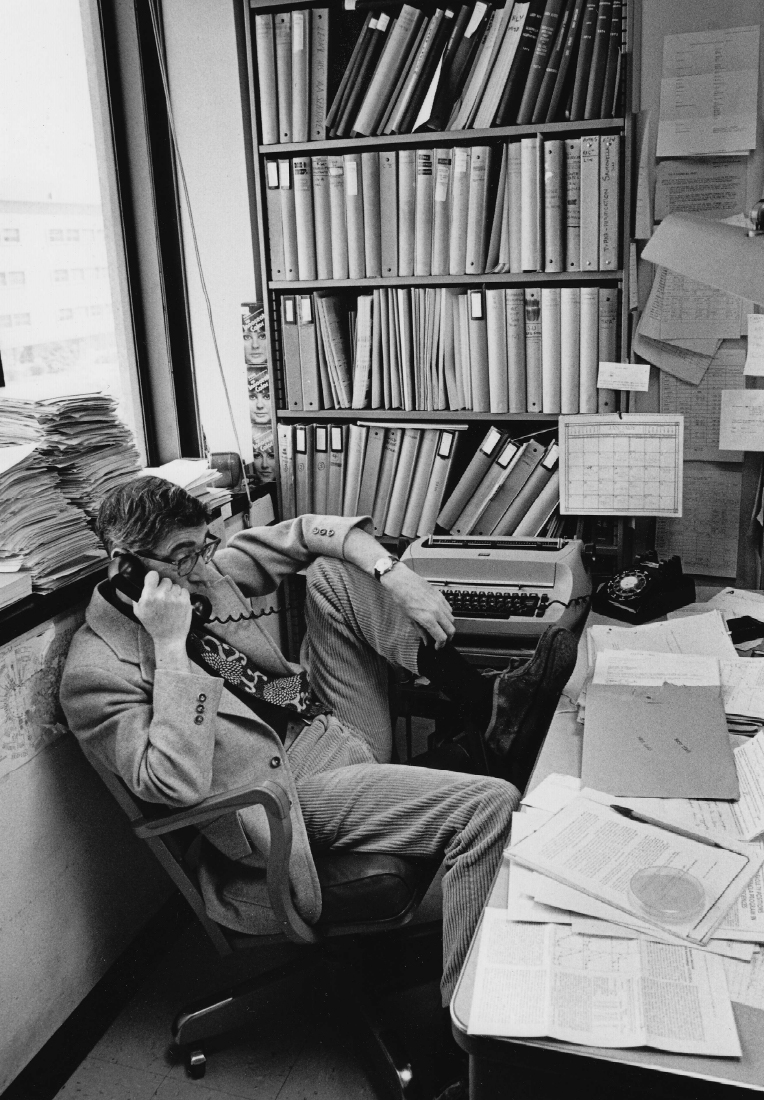
I realize that the title of this new oral history, “Bruce N. Ames: The Marriage of Biochemistry and Genetics at Caltech, the NIH, UC Berkeley, and CHORI, 1954–2018,” can give the impression of a sequence of institutional histories framed by the life of one researcher; it’s really more about a certain type of scientific inquiry that manifests itself as a career that is both varied and foundational to the work done at each of these places. Dr. Ames studied with H.K. Mitchell at the California Institute of Technology at the beginning of the revolution in molecular biology, which was the coming together of genetics, or the study of inheritance and development, and biochemistry, or the study of the chemical processes that underlie cellular processes. A key part of this revolution of course is the discovery of the helical structure of DNA by James Watson, Rosalind Franklin, and Francis Crick at Cambridge University. But to boil it all down, it became possible to see biochemical processes functioning not only as reactions to changing environments but also as the expressions of a genetic code that could be “switched on” or repressed experimentally. At Caltech, Ames displayed the kind of curiosity that endeared him to scientists like Max Delbrück, whose “phage group” was beginning to look at these biochemical mechanisms of genetics.
There was just a handful of sites in the early 1950s where this new work was being undertaken. Although Ames did his graduate training in biochemistry, he was always “hopping the fence” to look at what was going on in other disciplines, especially genetics. He joined the National Institutes of Health in 1953 as a fellow, and rose to become the Chief of the Microbial Genetics section in 1962. During his time at the NIH, Ames split a fellowship year at Crick’s laboratory at Cambridge and another at Francois Jacob and Jacques Monod’s laboratory at the Pasteur Institute. Historians of science have recorded their suspicions of some of these famous scientists, who learned of Ames’ idea that the biosynthetic pathways of histidine were achieved through the activation of several coordinated genes, which led to Jacob and Monod’s theory of the operon—which is a cluster of genes expressed by a common promoter—without attribution to Ames. Asked about it decades later, Ames seemed surprised that historians of science had documented this observation. But these research programs in which Ames participated laid the foundations of the molecular understanding of life: in 1961, Sydney Brenner (Crick Laboratory) and Monod published the discovery of messenger RNA, or mRNA—a copy of DNA that initiates cellular processes—which is the foundation of the new vaccines developed to protect against COVID-19.
What becomes apparent reading Bruce Ames’ oral history is that he himself functioned as a kind of synthesizer. A restless mind began a research track, produced results, but then became distracted by an active curiosity with respect to research in other areas of biology, or even in social sciences or political philosophy. In the labs he ran at NIH, UC Berkeley, or the Children’s Hospital of Oakland Research Institute, Ames generated interest among colleagues, post-docs, technicians, graduate students—even among undergraduate students or amateur activists—to undertake research in a new direction. Once the program was off the ground, Ames was often already thinking about new areas of research.
Such was not always an easy path, as the expected institutional rigidity and disciplinary boundaries sometimes made for cool receptions when Ames attempted to enter a new field. In the mid-1960s, just before he moved from the NIH to take up a professorship in biochemistry at UC Berkeley, Ames became interested in the chemical preservatives in potato chips. This was the beginning of a long research trajectory in genetic toxicology, or the impact of toxins on DNA, at a time when the relationship between DNA damage and diseases such as cancer was poorly understood. Out of this research, Ames developed a simple inexpensive bacterial test for the mutagenicity of chemical substances, what became known as the Ames Test, which cut dramatically the time and money it took to determine the degree to which chemicals caused cancer using the standard method, animal trials. In the wake of this success, Ames was also frustrated by what he saw as the institutional inertia and the misunderstanding of critics of science and industry. To advocate for a more balanced view of modernity, Ames applied his test to the plants humans eat every day, and found mutagenic chemicals that are produced by the plants themselves in far higher doses than the trace amounts of pesticide residues that accompany them.
In 2000, Ames retired from UC Berkeley and became a senior research scientist at the Children’s Hospital of Oakland Research Institute until his retirement in 2018. During this time, Ames followed the logic of his inquiries into plant toxicity to examine nutrition, specifically the micronutrients that protect our DNA from these mutagenic chemicals or processes. He then embarked on a third career — or fourth or fifth, depending on what we count — of research on micronutrients. With over 550 publications, he is among the top hundred most highly cited scientists across all disciplines. But perhaps more interesting than the story of a peripatetic and pioneering mind is Ames’ frequently proclaimed reliance on the talents of other researchers and technicians, whose widely varying backgrounds and skills, including those of his wife and fellow UC Berkeley scientist Giovanna Ferro-Luzzi Ames, complemented his talents and made the research possible. From oral histories of top scientists, we can easily conclude that science is about leadership, but the skill of leadership is revealed over and over to be the identification, nurturing, and coordination of diverse talents. That will surely be another of Dr. Ames’ lasting contributions to science.